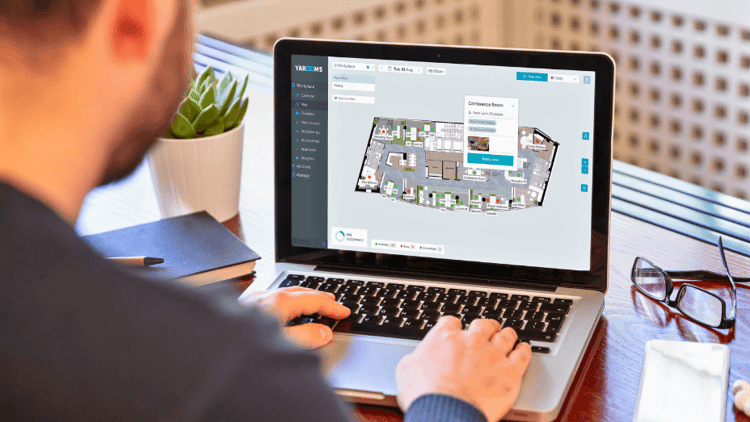Lack of visibility in the workplace. When you don’t know who’s in the office, where exactly in the office, what is everyone doing there, whom they meet when they come to the office, what meetings they attend…
This is one of the biggest dangers of hybrid work.
As it leads to:
- A lack of work culture
- Team members feeling disconnected from one another… isolated
- Lack of collaboration
- Workplace stress
- Lower productivity
- Poor or no insight into your employees’ engagement level
In this article, we’ll explain exactly how workplace visibility benefits your organization.
And explore effective ways you can increase it – with a focus on how workplace technology can help you build that culture of visibility.
Let’s dive in.
TDLR:
- This article explores the importance of workplace visibility, particularly in the context of hybrid work environments
- It discusses how visibility impacts productivity, collaboration, communication, and employee well-being.
- It also provides strategies for increasing workplace visibility, emphasizing the role of technology
- Overall, it highlights the benefits of knowing who is in the office and what they are doing, as it leads to better decision-making, accountability, and stronger team connections.

Visibility in the Workplace: Exploring Different Meanings
Usually, when you search for “visibility in the workplace”, it’s about personal visibility – when people know who you are and what you can do. About knowing who’s who and what their roles are in the organization.
But there’s also another kind of visibility: it’s about the workplace itself. Everyone’s location in the office space and what they’re doing.
What’s happening in there, who’s in the office, what in-person meetings are being carried out, where people are seated, what they are doing, etc.
And that is the type of visibility we will focus on in this article.
How Does Workplace Visibility Benefit Your Organization?
Why does it matter so much to have a high level of visibility within your organization?
How does this reflect in key performance metrics like productivity or quality of work? Or in the employee engagement level?
There are many benefits to ensuring your team easy access to the office activity: what’s happening in the office and who’s in.
Here are just a few:
It Helps with Accountability
Picture this:
You have employees coming to the office at regular intervals. You also have their colleagues know who’s coming in on what days.
And they all know which are the common projects they’ll be working on those days, in the office. Or what in-person meetings they’ll attend together.
In this scenario, holding themselves and their colleagues accountable for:
- meeting deadlines
- achieving KPIs
… gets much easier.
It Leads to More Effective Communication Between Team Members
And between managers and their teams.
Just think about it! There are so many employees working remotely or in a hybrid work model these days, communicating exclusively via tech.
Seeing each other, in person, and gaining visibility over how and when colleagues are meeting up to collaborate, plays a huge role in improving their communication.
Plus, with managers knowing exactly who’s coming to the office and when, they can get the most out of their teams’ on-site work.
And implement practices that promote communication in the workplace and a better understanding of team objectives and company goals.
It Helps Minimize the Time Wasted Looking for Someone (or Something)
When you know who’s in the office and where exactly you avoid scenarios like:
- using all the company’s communication channels trying to get in touch with someone on your team
- going to the office “hoping” specific people in your team will be there
- looking for certain files, info, or other types of shared resources you need to do your work
In short, giving your remote employees access to information on who’s in the office, and on which days, has a direct impact on their efficiency and productivity.
They’ll know where and when to find the team members they need to collaborate with, in person, to complete their common projects or share information with.
It Helps Team Members Build Strong(er) Relationships
With employees feeling connected to their colleagues – particularly remote ones, for whom this can be a real challenge – you reach a high employee well-being score.
And strengthen your workplace culture.
When remote workers know who’ll be at the physical workplace, they can plan their days at the office around that easily accessible information.
They can create opportunities to meet with (favorite) coworkers from various teams and even expand their networking outside working hours. Outside the office space.
Which will then translate into a higher engagement and level of motivation at work.
2 strong, direct benefits of visibility in the workplace that you can “reap” as an organization.
It Reduces the Risk of Micromanagement
And particularly in the context of hybrid work, managers are at a higher risk of falling into the temptation of micromanaging their teams.
Overseeing simultaneous projects and regularly reporting to their own superiors while their very teams are working on those projects remotely, can get them stressed out.
And tempted to micromanage their teams to be sure they stay on top of any delays in meeting deadlines or other problems that might occur.
But micromanagement – which comes with a lack of trust and a certain reserve to empower team members – leads to:
- Lower productivity
- Higher turnover
And this is where workplace visibility can help.
When managers have a bird’s eye view over who’s in the office at a particular time, it becomes easier for them to:
- gain more visibility into their teams’ work
- identify more quickly and accurately when a team member is overloaded
- get a clear overview of how the ongoing projects are progressing
… without the need for too frequent, too tedious update meetings.
In the end, office visibility – knowing who’s in the office and meeting with their team members in-person – makes… better managers.

The Impact of Visibility on Hybrid Workforce
Being productive and effective at work is hard work.
Being productive and effective at work (and feeling connected at the workplace) while you’re working in a hybrid workplace — when all you have are emails in your inbox and notifications on your phone, when you don’t know who’s in the office and what’s everyone doing there — is double as hard.
And this is where workplace visibility can help.
It Helps Them Achieve a Healthier Work-Life Balance
With information on who’s in the office, and on which days, workers in a hybrid work model can easily:
- schedule their in-office-days and their personal life activities so they don’t clash
- plan after-work drinks with their colleagues
- plan meetings and project updates around those days when they and their team members will be in the office
In short, an overview of the office activity for each day and each week enables employees in a hybrid arrangement to plan their workdays so that they achieve a healthier work-life balance.
It Facilitates Collaboration and Teamwork
When your hybrid workforce knows who’s in the office they:
- get a clear view of what specific projects are high priority at that point
- decide whether or not they should join their co-workers in the office to work together to help those projects advance more quickly
For nothing beats in-person collaboration. Even if it’s just now and then.
Working together, in the office, with their teammates, helps remote workers identify roadblocks more easily, it boosts their creativity and their problem-solving skills.
In other words, visibility in the workplace helps building more cohesive teams.
And more cohesive teams lead to boosted productivity at an organizational level.
It Makes Workers in a Hybrid Work Model Feel More Included
Hybrid workers struggle with the feeling that they’re being left out of important conversations.
That they’re not in the loop of decisions being made or simply informed about what’s happening in the office.
They feel isolated.
But when remote workers have easy access to information about:
- what colleagues are in the office
- what projects are being worked on each day
- what after-work activities are being planned daily and weekly
… so they can plan their workdays around them and join their colleagues in those activities, then they feel more included.
More engaged.
It Makes Remote Workers Feel More Connected to their Teams
And to the organization itself.
Feeling connected to their teams, to the company culture, and to the company itself is another challenge that remote workers have to overcome.
And by prioritizing office visibility you make it easier for remote workers to create opportunities to connect with their team members in person. At the office. And outside the office.
In short, office visibility can help them feel connected to the workplace, the team, and the company culture itself.
It Makes Them Feel More Engaged
You may be putting the best collaboration software at your hybrid team’s disposal.
And yet, it's periodic, in-person collaboration that will make team members feel more engaged.
It’s when working together, in the office, that they can share insights and knowledge more easily and feel more motivated to reach common goals.
And knowing when their team will be at the office will help a lot with synchronization and ultimately reaching that state of engagement.
How to Increase Workplace (Office) Visibility?
Adopt a Culture of Visibility
Build and maintain a culture of visibility and openness for your remote teams.
How?
- Create opportunities that stimulate face-to-face interactions with the help of virtual technologies
- Acknowledge employees’ contributions and invested effort
- Foster healthy relationships between co-workers
- Ensure all team members are visible in shared workspaces
In a nutshell, initiating and maintaining a culture of visibility is all about making everyone feel visible in the workplace.
And all about granting everyone visibility over what’s happening in there.
Communicate… Frequently and Transparently
Communication is critical for building trust and strong collaboration among co-workers in any work setting.
Communicate:
- project updates
- expectations
- achievements
- goals
- challenges
On the same note, calendar visibility plays a key role in bringing people together on the same page.
Make sure everyone communicates their working hours and that they make information about their days at the office visible to everyone on the team.
Encourage Coming to the Office
How? By nurturing work relationships between employees.
Once you achieve that, team members will be:
- more interested in who’s coming into the office each day
- more motivated to come in and join their favorite co-workers, too
As simple as that.
But how do you actually nurture those strong relationships?
By creating opportunities for employees to interact in person: think in-person learning events or different company social events.
Turn to Technology
The most effective way to make sure everyone has a clear overview of who is and who will be in the office on specific days is to adopt a workplace management software.
The right one.
Take YAROOMS, for instance, a workplace experience management platform that offers your workers full visibility over:
- Who’s in the office
- Who’s not in the office on a particular day
- Where everyone is seated in the office space
In short, they gain visibility into when their coworkers will be coming into the workplace.
With employees in a hybrid arrangement coming to the office at different times of the week, chances are they miss each other and the opportunity to collaborate on common projects is high.
Plus, with YAROOMS you and managers in your organization get to dive into valuable workplace analytics and analyze metrics like number of no-shows, average workspace utilization and foot traffic, employee satisfaction, etc.

Technology to Increase Visibility in the Workplace
Technology makes everything easier.
Here are 4 types of technology you should consider investing in if you want to reap the benefits of increased visibility in the workplace.
Work Scheduling Platforms
A (good) work planning platform will help your teams:
- assign tasks to the right people
- view scheduled tasks by calendar, board, list
- review completed ones
- schedule teamwork
- process data
In a nutshell, a good work scheduling platform will facilitate work planning and information sharing within and across teams.
Interactive Office Maps
They can provide you and your workers with real-time updates on:
- current and future workspace availability: available workstations
- updates on available, busty, or disabled spaces
- space features
- colleagues who booked various workstations on specific days
The direct benefits of using an interactive office map?
- It takes planning to a whole new level
- It boosts efficiency and productivity
- It streamlines communication: it enables team members and people from different teams to coordinate meetings and brainstorming sessions
- It makes it easier for individuals and teams to work together: this enhanced workplace visibility offers everyone transparent access to company-wide information and resources
And an overview of the different occupants, the different departments in the company.
Integrated Workplace Platforms
With a major focus on the integrations that your workplace management platform of choice facilitates.
As it’s them — the entire toolbox of tools and technology needed to provide the best workplace experience to your employees — that draws the line between a good workplace platform and THE right workplace platform for your organization.
With this single hub pulling insights from different platforms, automating workflows, and sharing information (real-time information about who’s booked which workspaces on which days here included) your teams can grow more effective and productive.
Employee Mobile Apps
Go even further and put all the day-at-the-office, in-person meetings planning, and teamwork scheduling capabilities right in your employees’... pockets.
The right employee mobile apps will help your teams:
-
Get an overview of all the upcoming meetings and bookings made by their co-workers
-
Check themselves into specific meetings with… just a few finger taps
-
Book workspaces and meeting rooms on the go
So, Why It’s Important to Know Who (And Where) Is in the Office?
Because it boosts your teams’ productivity and it increases teamwork.
Particularly in the case of a hybrid team – who communicates almost exclusively via screens – being able to see when and where those colleagues on their screens meet, in person, has a huge impact on their sense of connection to the workplace.
And it’s this level of office visibility that adds the human experience to the entire workplace experience. The one responsible for the employees’ level of commitment to your organization.












